
 |
| Sable. |
Arms simply sable are found to have been borne by the following families:--GOURNEY(a Norfolk family); DOMBALE; GLEGG; and LORRAINE.
 |
| Sabre. |
Or, a lion rampant sable holding in his dexter paw a sabre or crooked sword proper, all within a double tressure flory counterflory of the second--MAC CAUSLAND, Strabane, Ireland.
Gules, a fesse cotised or, over all two sabres addorsed saltireways azure hilt and pomel of the second--AGALL.
 |
| Falchion. |
 |
| Scimetar(engrailed). |
Or, a lion rampant double tailed and ducally crowned, brandishing in the dexter paw a falchion all gules--PAUL, Middlesex; granted 1758.A French term Badelaire is found sometimes used; it seems to be similar to the sabre.
Azure, a falchion in pale argent hilt gules--TATNELL, co. Chester.
Gules, three hangers or falchions barwise in pale the points toward the sinister part of the shield argent, hilts and pomels or--HUDGSON, Boston, co. Lincoln.
Azure, three scimetars in pale argent hilts and pomels or, the points to the sinister--HODGSON, Tooting and Buckland, Surrey.
Ermine, on a chief gules three cutlasses erect argent hilts or--HODGSON, Framfield, Sussex; granted 1628.
Or, three bars wavy gules with a scimetar in pale argent, hilt and pomel of the field--DRUMMOND.
Argent, a cutlass in bend sable--ELAM, Kent.
Gules, three cutlasses in pale barry argent[?] neufes or--TROSS, co. Devon.
De gueules, à trois badelaires d'argent rangés en pal--DU BOIS, Bretagne.
 |
| Seax. |
Gules, three seaxes barwise proper, hilts and pomels or[handles to the dexter and edges of blades uppermost]--County of MIDDLESEX.Sackbut. See under Pipe.
Argent, a lion rampant sable; on a chief gules two seaxes in saltire of the first, tilts and pomels or--GOMME[Middlesex, 1761]
 |
| Saddle complete. |
Azure, a chevron between saddles with stirrups[otherwise three manage saddles complete] or--COMPANY of SADDLERS, London.
Argent, three saddles sable--HARVEY, Norfolk.
Gules, a horse armed or, bridled and saddled of the first, with a plume on his head, and trappings, and on his shoulder a cinquefoil of the last: on his hip an escutcheon charged with a cross all between three garbs of the second--MALT.
Le roy de Norwey de goules a un cheval dor selle--Roll, temp. HEN. III.
 |
| Pack-saddle. |
Azure, three pack-saddles or--HERVEY, Tiddington, Oxon.Sagittarius. See under Satyr.
Azure, the Apostle S.Andrew proper surrounded with a radiation or, vested of the field, tied to his cross, argent; in base a boar of the last tied to a tree of the second--Burgh of S.ANDREW'S Scotland.Saker=Sacre.
Argent, S.Boniface on the dexter habited gules his hand across his breast proper; on the sinister a bishop vested in long robe close girt purpure, mitred and in his sinister hand a crosier or--See of ROSS, Scotland.
The figure of S.Bryce vested in long garments with a mitre on his head, all proper standing in the porch of a church argent, which is ensigned on the top with a cross pattee of the third; his dexter hand holds a fleur-de-lys or, and the sinister hand is laid upon his breast; the whole between a decrescent and a star in fesse of the last--Seal of the Royal Burgh of KIRKALDIE, Scotland.
Azure, S.Columba in a boat on waves of the sea all proper; in chief a blazing star or[otherwise dexter chief a star gold]--Bishopric of THE ISLES, Scotland.
Azure, a church argent, S.Giles standing in the porch in a pastoral habit proper mitred and in his dexter hand holding a passion cross, the sinister hand holding a book proper--See of MORAY.
Argent, S.Magnus vested in royal robes, on his head an antique crown in his dexter hand a sceptre, all proper--See of ORKNEY, Scotland.
Argent, in the sea azure a galley, her sails furled sable; in the middle thereof S.Margaret, Queen of Scotland, standing richly apparelled, in the dexter hand a sceptre ensigned with a fleur-de-lis or, in the sinister which is plain on her breast a book folded purpure--Burgh of QUEENSFERRY, Scotland.
Argent, the Archangel Michael proper vested in a long garment azure; in the dexter hand a crozier or, on the head a mitre, and below his feet a serpent nowed, both proper--Burgh of DUNDEE.
Azure, S.Michael with wings expanded, treading on the belly of a serpent in base lying fessways with its tail nowed, all argent, with a spear in his dexter hand piercing the serpent's head proper and holding in the sinister an inescutcheon charged with the royal arms of Scotland--Burgh of LINLITHGOW, Scotland.
Argent, S.Ninian clothed in a pontifical robe purple, on his head a mitre and in the dexter hand a crosier, both or, the sinister hand across the breast--See of GALLOWAY, Scotland.
Per fesse gules and azure, in base a Cross Calvary supported by a Saint on steps proper; in chief two keys saltirewise or--Bishopric of CASHEL, EMLY, WATERFORD, and LISMORE.
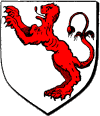 |
| PETIT. |
Argent, a lion salient gules--PETIT, Cornwall.Salix. See Willow.
Vert, three bulls salient argent--Rowland LEE, Bp. of Lichfield and Coventry, 1534-43.
Azure, a cat salient argent--BLAIR.
Argent, a greyhound salient party per long sable and of the first--DE LA FORDE, Iver, co. Bucks.
Argent, a bear salient sable; a canton gules--John BEERE, Kent, 1586.
Argent, two foxes counter salient in saltire gules, the dexter surmounted by the sinister--WILLIAMS, Anglesey.
 |
| SALMON. |
Sable, three salmon hauriant argent--John SALMON, Bp. of Norwich, 1299-1325.With the salmon is allied the Trout(fr. truite), and there is practically no difference in the drawing. Mr.Moule thinks when a fish is shewn in, or near, a river, and not distinctly named, it is intended for the trout, but does not give conclusive reasons. The French employ the trout, and frequently apply to it the term marqueté, i.e. in reference to the spots.
Gules, three salmon hauriant argent--Family of GLOUCESTER.
Gules, two salmon in pale argent finned or--SAMS, co. Essex.
Gules, a salmon in fesse argent--PISAGE.
Argent, a tree growing out of a mound in base, surmounted by a salmon in fesse all proper, in his mouth an annulet or; on the dexter side a bell pendent to the tree of the second--Royal Burgh of GLASGOW.
Three salmon hauriant in pale argent--Town of KINGSTON-UPON-THAMES.
Gules, a salmon's head couped argent with an annulet through its nose proper, between three cinquefoils of the second--HAMILTON, Scotland.
 |
| TROUTBECK. |
Azure, three trout[interlaced, or] fretted in triangle, 'testes aux queues' argent--TROUTBECK of Cornwall.There are one or two other fish which should be here noted, such as the smelt(fr. eperlan), known in Scotland as the sparling. The 'grayling' is perhaps intended in the crest of the family of GRAYLEY; while the French name for the same, ombre, may have suggested the fish in the arms of the UMBRELL family.
Azure, two trout[? ged] in saltire argent--GEDNEY, or GEDENEY.
Gules, a trout in bend argent--NEVE.
Argent, on a bend sable three trout or--OSBORNE, London.
Sable, a chevron or between three trout hauriant argent--FOREMAN, Scotland.
D'azur, à une truite d'argent en bande, marquetée de sable, accompagnée de 6 étoiles d'or en orle--ORCIVAL, Auvergne.
Azure, a chevron between three smelts naiant argent--SMELT, co. York.The salmon spear occurs on the arms of two branches of the Cornish family of GLYN. The form this spear takes has been given under Eel-spear.
Erminois, three sparlings hauriant two and one proper--SPARLING, Petton, co. Salop.
Argent, three umber fish naiant--UMBRELL.
Argent, three salmon spears points downwards sable--GLYNN, co. Cornwall.
 |
| Sprinkling salt. |
Per chevron, azure and gules, three salt-cellars[otherwise sprinkling salts] overflowing argent--The SALTERS' COMPANY, London. Arms granted, 1530. [Example on brass at All Hallows, Barking.]Saltant, (fr.): a term sometimes applied to small animals springing forward, instead of rampant, e.g. of a goat, or ram; perhaps not to be distinguished from salient.
Sable, a bend argent between three covered salts or--FELLINGHAM.
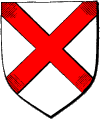 |
| FITZ-GERALD. |
 |
| KIDDER. |
 |
| WOLTON. |
Robert de BRUS, d'or, ung saltoir de goules; et ung cheif de goules--Roll, temp. HEN. III.As to the expression a saltire lozengy, as has been said respecting the Cross Lozengy(see §8), there seems to have been great carelessness in the blazon by the heralds of the seventeenth and eighteenth centuries. It should be described where there is one tincture, a saltire of so many lozenges, &c. The first example of the following is clear; the others leave it obscure as to what is meant, and how the lozenges, &c., should be arranged.
Foulke de ESCHARDESTON, de goules ung sautoir d'argent engrele--Ibid.
Sire Raudolf de NEVYLE, de goules a un sautour de argent--Roll, temp. ED. II.
Monsire Rauf de NEVILL, port de gules une salter d'argent--Roll, temp. ED. III.
Monsire de TIBETOT, port d'argent une salter engrele de gules--Ibid.
Argent, a lion sejant gardant gules armed and langued azure holding in his dexter paw a thistle proper, and in his sinister a shield of the second, on a chief azure a S.Andrew's cross of the first--LYON OFFICE, or OFFICE OF ARMS AT EDINBURGH.
Argent, on a saltire gules an escallop or--See of ROCHESTER. [The Cathedral Church being dedicated of S.Andrew.]
Argent, a saltire counter embattled sable--Richard KIDDER, Bp. of Bath and Wells, 1691-1703.
Argent, a saltire azure botonny or--BASINGHOLD.
Gules, on a saltire argent, another humetty of the field; in chief a mitre coroneted, stringed or--Arms ascribed to GERARD; Bp. of Hereford, 1096; of York, 1100-8.
Gules, four quatrefoils two and two or; in base a saltire couped argent--PALMER, co. Warwick.
Argent, a cross moline saltirewise--BANESTER.
Or, a lion rampant supporting a saltire engrailed humetty gules--John WOLTON, Bp. of Exeter, 1579-94.
Ecartelé aux 1 et 4 d'azur, au chevron ondé d'argent, accompagné de trois têtes de léopard d'or languées de gueules; aux 2 et 3 de gueules, au sautoir d'or engoulé de quatres têtes de léopard mouvantes des angles chargé en cœur[i.e. in fesse point], d'une autre tête de léopard du champ--DE JACOB DE LA COTTIERE.
Or, a saltire lozengy gules and argent--BELHOUSE.
Or, a saltire lozengy vert--BELHOUSE.
Vert, a saltire lozengy or--FRANKES, also MALCAKE.
Vert, a saltire fusily or--FRANKE.
 |
| JULIAN. |
Argent, a cross of S.Julian[otherwise cross crosslet in saltire] sable--JULIAN, co. Lincoln.
Argent, five crosses Julian in saltire sable--THOROWGOOD.
Azure, a chevron per paly and per chevron gules and argent counterchanged, between three garbs or; on a chief argent two batons crossed at each end sable in saltire, the dexter surmounted by the sinister, commonly called S.Julian's Cross--INNHOLDERS' Company, [Inc. 1514].
 |
| BATH and WELLS. |
Azure, a saltire per saltire quartered or and argent; on the dexter side two keys erect, interlaced at the bows, one or the other argent; on the sinister a sword erect--Bishoprick of Bath and Wells united, as borne by Bp. MONTAGUE in 1608(Edmondson).
 |
| Borough of SOUTHWARK. |
Azure, an annulet ensigned with a cross pattée or, interlaced with a saltire conjoined in base of the last--Borough of SOUTHWARK.Saltirewise, and in saltire, (fr. passé en sautoir), are words used to describe the position of charges placed in the form of that ordinary. The former is properly applied to two long charges, as swords, q.v., fishes, &c., when crossing each other bendwise, and the latter to five charges, placed 2, 1, 2; but, as will be observed, the terms are practically interchangeable, the latter, however, being more frequently used.
Gules, two scythes in saltire argent--PRAYERS.
Gules, a fesse countercompony or and azure between six crosses crosslet argent placed saltireways--BUCK, Wisbeach, co. Cambridge.
Gules, five crosslets fitchy in saltire between four escallops or--TOWNSON, Bp. of Salisbury, 1620-21.
 |
| GREENLAND. |
Argent, three saltires vert--GREENLAND.Per saltire, see Quarterly per saltire.
Or, a saltire gules surmounted by another ermine, on a chief of the second three saltorels engrailed of the first--DYON, co. Lincoln.
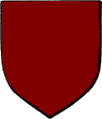 |
| Sanguine. |
Per bend sanguine and vert, two greyhounds courant bendwise argent--CLAYHILLS, Innergowrie, Scotland.Sans: used by heralds for without, e.g. a dragon sans wings.
Argent, on a bend sable three satyr's heads couped at the shoulders of the first horned or--WHEYWELL.Sagittarius, or a Centaur, is composed of half man and half horse, the former holding an arrow upon a bended bow. It is one of the twelve zodiacal signs, and King Stephen is said to have assumed it, because the sun was in that sign when he ascended the throne.
Sable, three man-tigers(or lampagoes) in pale argent--RADFORD, Cheynstone, Chawleigh, co. Devon.
Gules, the bodies of three lions passant to the neck, with man's heads or[otherwise sagittarii]--Fictitious arms ascribed to King STEPHEN.Sauterelles, (fr.): grasshoppers.
Gules, a sagittarius argent, his bow and shaft sable--BLOYS.
A sagittarius in full speed proper, shooting with a bow or and arrow argent--Crest of ACADEMY OF THE MUSES, London.
 |
| HAMILTON. |
Out of a ducal coronet an oak-tree fructed proper, cut through the main stem by a framesaw proper, the frame or--Crest of HAMILTON, Duke of Hamilton and Brandon.Saxon. See Head.
Argent, a chevron engrailed gules between in chief two escallops of the last, and in base a handsaw palewise azure handle or--SAWERS, Scotland.
Or, within a double tressure flory counterflory with fleur-de-lis sable a lion rampant of the second, holding in his dexter paw a crooked saw proper[otherwise a sabre]--MAC CAUSLAND, Strabane, Ireland.
 |
| Sceptre. |
Azure, a sceptre in bend between two crowns or; a chief of the last--FOX.Scimetar. See Sabre.
Vert, a sceptre surmounted of another in saltire or--PERSE.
Azure, three sceptres in bend or--PORTREA, Barnstaple.
Azure, three fleurs-de-lis or for Montgomery; quartering in second and third gules three annulets or gemmed azure for Eglinton; all within a bordure gold charged with a double tressure flory counterflory gules; on a surcoat[i.e. escutcheon over all] of the last a sword and sceptre saltireways proper--MONTGOMERY, Earl of Mount Alexander.
Azure, a pair of scissors expanded in saltire, their points in chief or--Company of TAILORS, Edinburgh.
 |
| Scoop. |
Argent, a scoop sable, with water therein wavy purpure, between four leaves in saltire of the second--SCOPHAM, co. Lincoln.
 |
| COLE. |
Argent, a fesse between three scorpions erect sable--COLE, Somersetshire.Scourge: scourges with three lashes to each, which occur in the insignia of Croyland Abbey, (See under Knife), are referred to as S.Guthlac's scourges.
Argent, a fesse engrailed between three scorpions reversed sable--COLE, Brancepeth, Durham.
Argent, a chevron between three scorpions reversed gules--COLE, co. Devon; and Walden, Essex.
Argent, a bend of five lozenges conjoined azure between two cotises vert, and as many scorpions sable--O'SINAN, Ireland; Harl. MS. 4039, fo. 235.
 |
| SCOTLAND. |
Or, a lion rampant gules--SCOTLAND.The lion first appears distinctly upon the seal of Alexander II., 1214-49, but whence derived, or whether then first assumed, it is impossible to say. Afterwards the Lion was surrounded by a double tressure.
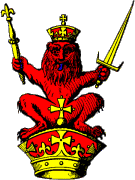 |
| Crest of Scotland. |
Or, a lion rampant within a double tressure, flory counterflory gules.The double tressure is sometimes referred to as the Bordure of Scotland.
The Crest[Upon an imperial crown proper]. A lion sejant affronté gules, imperially crowned or, holding in his dexter paw a sceptre, and in his sinister a sword[both proper].
Supporters. Two unicorns argent, gorged with a royal coronet and chained or.
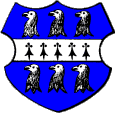 |
| SPENCER. |
Azure, three sea-gulls argent--David LLWCH.
Gules, a fesse wavy argent between three sea-gulls proper; a crescent for difference--MEDLAND, Launceston, co. Cornwall; granted 17 May, 1730.
Gules, three sea-mews argent beaked and legged or--MEWY, co. Devon.
Azure, three mews argent beaked and membered gules--ASHE.
Azure, a fesse ermine between six sea-mew's heads erased argent--SPENCER, Wormleighton, co. Warwick.
Gules, a fesse engrailed between three sea-mews argent--SYER, Isham, co. Northampton; granted 1614.
Gules, a fesse between three tern-fowls argent--YERLE.
Or, a fesse dancetty ermine, in chief a sea-pewit vert beaked and legged gules--QUARLES, co. Northampton.
Gules, a chevron between three sea-pewits argent--SAYER, Preston, co. Durham.
Sable, a chevron between three sea-fowl close argent--SEAFOWLE.
 |
| Sea-horse. |
 |
| TUCKER. |
 |
| GLYNN. |
Argent, in a sea vert a sea-horse issuing rampant proper--ECKFORD, Scotland.
Azure, a chevron between three sea-horses or--TUCKER, of Milton, Kent.
Barry wavy argent and azure; on a chevron crenelly or, between three sea-horses silver, finned and unguled of the third, seven gouttes-de-poix--TUCKER, co. Devon.
Azure, four bars argent between three sea-horses or; over all on a chevron crenelly of the last five gouttes-de-poix--TOOKER.
Per pale or and azure; on the dexter compartment a tower gules, and on the sinister on a mount vert a sea-horse argent, mane, fins, and tail of the first; on a chief gold three mullets of the second--GARRICK, Middlesex.
Argent, on a fesse gules between three sea-horses sable a cross crosslet fitchy between two trefoils slipped of the first--NORDEN, Kent.
Barry of six argent and azure; surtout three sea-horses naiant or--William GLYNN, Bp. of Bangor, 1555-58.
Chequy argent and gules, a lion rampant gardant or; on a chief of augmentation wavy azure a sea-horse naiant proper between two Eastern coronets or, and above the word "Havannah"--POCOCK, co. Durham, Bart.
 |
| Sea-lion. |
Argent, a sea-lion couchant azure, crowned, armed and langued gules--SILVESTER.The sea-dragon is also to be classed amongst monstrosities, though it has been suggested it is intended for the conger-eel, and thus the heads in the insignia of KING'S LYNN have been blazoned 'dragon's heads.' Again, when the term occurs in the blazon of the crest of Sir Jacob GERRARD, Bart., 1662, it is said to be a wyvern.
Azure, a bridge of three arches embattled at top in fesse argent, masoned sable, between three sea-lions passant or--BRIDGEN, Lord Mayor of London, 1764.
Or, on a bend wavy between two sea-lions sable three buck's heads caboshed argent--Sir Robert HARLAND, Bart., Orwell Park, Suffolk. [A sea-lion supporting an anchor, crest of the same.]
Per chevron gules and or; three sea-dragons ducally crowned counterchanged--EASTON, co. Devon.The sea-dog is still more uncertain. It has been suggested that the device is intended for a crocodile, but this results only from bad drawing. With better reason it is suggested to be a fanciful representation of the otter: but like all monstrosities the origin must be looked for in the imagination of the draughtsman rather than in the realm of nature. It is drawn like a talbot, with the whole body scaled, and the tail of a beaver. The feet are webbed and the back scalloped like that of a sea-horse.
Argent, three demi sea-dogs passant in pale sable--JESSE.The sea-wolf also belongs to the same category, and this has been supported only to be the seal.
Per fesse nebuly ... and ... three sea-dogs passant counterchanged--HARRIS, Cornwall.
[Baron STOURTON has two such animals, sable, scaled or, for his supporters.]
Argent, a chevron engrailed gules between three marine wolves(or sea-dogs) naiant sable finned, ventred, and dented of the first, langued of the second--FENNOR, Sussex; granted 10 November, 1557.It should be added that the French treat several land animals in this manner by adding the tails of fish to them, and they have a special term to signify the same, viz. mariné.
 |
| ALSTANTON. |
Azure, three sea-urchins erect argent[Otherwise Gules, three sea-urchins in pale argent]--ALSTANTON.Seals: attached to a book, q.v.
Azure, three urchins passant in pale or--WOOD.
Argent, a[lever or] cormorant sable beaked and legged gules, holding in the beak a branch of seaweed called laver inverted vert[originally the eagle of S.John holding a penner and inkhorn]--City of LIVERPOOL.
D'argent, a une feuille de varech de gueules accostée de deux crois sants d'azure--BEUARD, Normandie.
 |
| Seal's paw. |
 |
| Lord LEY. |
Argent, a chevron between three seal's paws erased and erect sable--Town of YARMOUTH, Norfolk.Seax. See Sabre.
Or, a seal's foot erect and erased proper--BERINGBURGH.
Azure, a ducal coronet or between three seal's heads erased argent--BURMAN, Stratford, co. Warwick.
Argent, a chevron between three seal's heads bendwise couped sable--LEY, co. Wilts, Barony, 1625; also LEY, co. Devon.
 |
| STRODE. |
Argent, three conies sejant sable--STRODE, co. Somerset, 1716.Sejant affronté is applicable to a lion borne in full aspect. See the crest of Scotland.
Argent, a chevron between three spaniels sejant gules--HOMLING.
Sable, a chevron ermine between three lions sejant gardant argent--LYONS.
Or, a bear rampant sejant sable--BERNEK.
Gules, a lion sejant on a chair, and holding in the paws a battle-axe or--Fictitious arms assigned to ALEXANDER the Great.
 |
| DE LUXEMBOURG. |
Sr JOHN de Bretaigne, porte eschekere d'or et d'azur, ou le cantell d'ermyne ou le bordure de gulez poudre ou lepars d'or--Roll, temp. HEN. III.Senestré par, (fr.): having another charge on the left hand.
Per fesse gules and sable, a lion rampant argent semy of crosses croslet of the first--LODGE, co. York.
Gules, semy of nails argent, three stems of a flower vert--ASHBY.
Azure, semy-de-lis and a lion rampant argent--HOLLAND.
Gules, semy-de-lis or, a lion rampant and a canton ermine--MARKS, Suffolk.
Or, semy of hearts and in chief a lion rampant gardant azure--GOTHES.
Or, on a chevron gules, within a bordure azure semée of mitres[better, charged with eight or more mitres] of the first--Edmund STAFFORD, Bp. of Exeter, 1395-1419.
Chequy argent, semée of torteaux, and azure semée of fleur-de-lys or--Louis de LUXEMBOURG, Bp. of Ely, 1438-43, [and Archbishop of Rouen, 1443-56].
Le REY DE FRAUNCE, de asur poudre a flurette de or--Roll, temp. HEN. III.
Rauf le FITZ NICOLE, de goules, ung quintefueil de or; le champ pleyn des escallopes d'argent--Ibid.
Or, the field replenished with estoiles azure, a lion rampant gules--GALLYHALT.
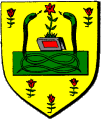 |
| KAYE. |
"Gold semied with flowers gentil, a sengreen in chief over the heads of two whole serpents in pale, their tails knit together(all in proper colour) resting upon a square marble-stone vert, between these a book sable garnisht gules buckled gold"--Dr.John KAYE[co-founder with GONVILLE of Gonville and Caius College, Cambridge, temp. Queen Mary].Sepurture: a term applied to the wings of birds, q.v.; synonymous with endorsed.
 |
| Erect. |
 |
| Involved. |
Le Counte de TRERSTEYN, dor a un byse de goules--Roll, temp. HEN. III.
Monsire William MALBIS, d'argent a une cheveron de gules a trois testes de bys rases gules--Roll, temp. ED. III.
Argent, a chevron gules between three serpents erect proper--COTTER, Bart, 1763.
Argent, two serpents erect endorsed--LONGSHARE.
Or, three serpents erect wavy sable--CODLEW, or CUDLEW.
Argent, three serpents gliding in pale azure--DUCAT.
Argent, two bars gules; over all as many serpents erect, respecting each other, vert--REFUGE.
Argent, a serpent involved vert--O'DRONE, Ireland. [Another family, three snakes involved vert.]
Argent, three serpents voluted--DIGON, or TROGONE, Ireland.
Azure, three serpents encircled or; two and two--WHITBY Abbey.
D'argent à la guivre d'azur, tortillante en pal, [generally blazoned 'couronnée d'or,'] 'engloutissante un enfant' issante de gueules--Duché. de MILAN.
 |
| Nowed. |
 |
| Nowed reversed. |
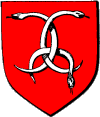 |
| EDNOWAIN AP BRADWEN. |
Argent, two serpents nowed and linked together in pale between two stars gules--ARWELL, Scotland.Serrated: having a saw-like edge, e.g. of a sickle blade.
Gules, three snakes nowed in triangle argent--EDNOWAIN AP BRADWEN, Merionethshire.
Gules, three snakes nowed in triangle argent, within a bordure engrailed or--LEWIS, Warwickshire.
Vert, a serpent bowed embowed debruised, the head erect, the tail torqued or--BLOORE.
Azure, three serpents, each encircled, their tails in their mouths argent[in French blazon, 'D'azur, a trois serpents d'argent arrondis se mordant la queue, posées 2 et 1']--DE LAUZON, Poitou.
Azure, a bend or in chief three boy's heads couped at the shoulders argent, each enwrapped about the neck with a snake proper; in base as many griffin's heads erased of the third--MADOCK, co. Gloucester.
Gules, a stellion[?] serpent proper--BUME.
Simon de VEER, de goules trois sixfueilles d'ermyn--Roll, temp. HEN. III.Angemmes, (fr. from lat. ingemmœ), are described as a series of round ornaments drawn like quatrefoils, but with six leaves, and seem to be confined to French heraldry.
Monsire de PIERPOUNT, port d'argent, a une lyon de sable rampant et une urle de seyfoils[often drawn as cinquefoils] gules--Roll, temp. ED. III.
Sire Johan DARCY de argent, a un escuchon de sable, od les rosettes[otherwise blazoned sistefoils] de goules assis en la maniere de bordure--Roll, temp. ED. II.
Argent, ten six-foils[intended for roses] gules, four, three, two, and one--Joan ROSELEE, Roll, temp. ED. I.
Sable, three sixfoils within a bordure engrailed or--Walter de WIGTONE-[From the coloured roll in possession of Society of Antiquaries].
De gueules, à un écusson d'argent à la bordure d'angemmes d'or--TANCARVILLE.Shacklebolt. See Fetterlock.
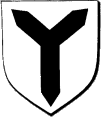 |
| CUNNINGHAM. |
Argent, a shake-fork sable--CUNNINGHAM.Shambrogue, or Shambrough, is defined by Berry and other heraldic writers as a kind of ship; but it is more probably a kind of boot, (cf. Irish brogue under boot).
Argent, a pale furché between two cotises sable--CUNNINGHAM.
Argent, a shake-fork sable charged with a cinquefoil of the first--CUNNINGHAM, Glengarnock.
Argent, a rose vert between three shake-forks sable--SMALLSHAW, Bolton, co. Lancaster.
Azure, on a shake-fork between two mascles in chief, and a boar's head erased in base or, three laurel leaves vert--KINLOCH, Scotland.
Azure, on a bend or three shambrogues gules--PEDE, Bury, Suffolk.Shamrock. See Trefoil.
Or, on a bend sable, three shambroughs argent[otherwise Or, on a bend sable three legs in armour couped at the thigh, and erased at the ankle proper]--BLAGRAVE.
Azure, a shark or; a chief of the last--VALLIANT.Shave. See Currier's shave.
A shark issuing regardant swallowing a man--Crest of family of YEATES, Ireland.
A shark's head regardant and swallowing a negro--Crest of family of MOLTON.
Argent, three dog-fishes naiant in pale sable--GESSE.
A demi dog-fish--Crest of family of MEER, Dorset.
D'azur, a trois moutons passant d'argent, accornés de sable, accolés de gueules, et clarinés d'or; à la bordure engrêlée et gueules; au chef cousu de France--BOURGES.Sheldrake. See Duck.
D'azur, a une brebis d'argent--BERBISY, Bourgogne.
Azure, on a chevron sable, a gauntlet of the first between two pairs of swords in saltire of the last, hilts and pommels or; on a chief of the second, an oval shield of the field charged with a cross gules encircled with a carved shield of the third, between two peer's helmets proper garnished gold--Company of ARMOURERS, incorporated temp. HEN. VI.The target may be reckoned amongst shields, occurring as it does in the feudal coat of the Lordship of ROTHSCHILD. An archery Target seems also to have been adopted.
Argent, on a mount in base the trunk of an oak tree sprouting out two branches proper with the Shield of Pallas hanging thereon or, fastened by a belt gules--BOROUGH, co. Derby.
Gules, a target between three antique crowns or--GRANT, Ballindalloch, co. Elgin.Ship, (fr. navire or vaisseau): this is a very frequent device, and especially in the insignia of sea-port towns and of merchant companies. The form varies greatly in different examples, being for the most part copied from the existing fashion. When ships are named they should be most scrupulously blazoned, care being especially taken to state the number of masts and top-masts, whether there are any sails(fr. voiles), and if any, whether they are furled or not. The rigging, too, it will be seen is often of a different tincture. It will be noted that the hulk of the vessel is often named, and sometimes the stern. Ships and Castles are so exceedingly varied in form that they present greater difficulties than almost any other bearings.
 |
| MEARES. |
Argent, a three-masted galley, her sails furled proper[otherwise a ship with three masts, sails furled and shrouded proper]--MEARES.With the French when the masts are of a different tincture the term equipé is used, and when the sails are so, habillé.
A ship of three masts in full sail on the waves of the sea; the mainsail charged with a lion rampant, and the sail on the foremast charged with a cross of S.George; on the round top of each mast are four spears with their barbed points upwards--Seal of town of ALDBOROUGH, Suffolk; granted 1561.
Gules, a fesse ermine, in base a ship with three masts, sails furled proper--CRAWFURD, Passell.
Argent, in base a lion passant gules and in chief a three-masted ship sails set ... --O'LEARIE, Ireland.
Azure, semy-de-lis or, a lion rampant of the last; on a canton argent, a ship in full sail proper--POOLE, co. Chester.
Argent, on waves of the first and azure a three-masted ship in pale sailing to the sinister sable; on a chief of the third a lizard or--MAC SHEELEY.
Quarterly, first and fourth or, a lion rampant gules; second azure a ship at anchor within a royal tressure or; third azure, a ship in full sail or; over all dividing the quarters, a cross engrailed gules--SINCLAIR, Mey, Scotland.
Azure, in base a sea with a dolphin's head appearing in the water all proper; on the sea a ship of three masts in full sail all or, the sail and rigging argent, on each a cross gules; on the dexter chief point the sun in splendour; on the sinister chief point an estoile of the third; on a chief of the fourth a cross of the fifth charged with the lion of England--Company of SPANISH MERCHANTS.
Azure, on a sea in base proper a ship with three masts in full sail or, between two rocks of the second, all the sails, pennants and ensigns argent, each charged with a cross gules; a chief engrailed of the third; in base a sea-horse proper--LEVANT COMPANY[TURKEY MERCHANTS].
Azure, three ships of as many masts rigged and under full sail, the sails, pennants and ensigns argent, each charged with a cross gules, on a chief of the second ... (see Pale)--EAST INDIA COMPANY; arms granted 1600.
Barry wavy of six argent and azure; over all a ship of three masts in full sail proper, sails, pennants, and ensigns of the first each charged with a cross gules all between three bezants; a chief or, on a pale between two roses gules seeded or barbed vert a lion passant gardant of the fifth--RUSSIA MERCHANTS, incorporated 1555.
D'azur, au navire d'or, equipé et voilé d'argent, flottant sur des ondes de même--HERAIL, Languedoc.
De gueules, au navire d'or, habillé d'hermine, voguant sur des ondes au naturel; au chef cousu d'hermine--Ville de NANTES.
 |
| Demy Hull. |
 |
| Sail. |
 |
| CINQUE PORTS. |
Barry of six argent and azure three hulks sable; on a chief gules three lions passant gardant or--City of WATERFORD.The term antique or ancient ship sometimes means the Lymphad, q.v. When oars are named(as in the arms of SINCLAIR), though the charge is called a ship, it is meant probably far a galley. A Spanish merchant-ship occurs in the arms of FAVENC(see under Mulberry), and the Noah's ark, borne by the Company of SHIPWRIGHTS, has been mentioned in its proper place. The shambrogue(q.v.), which writers refer to as a ship, seems not to be a ship at all.
Per pale gules and azure; on the dexter three demi-lions passant gardant issuing from the centre and conjoined to so many demi-hulks of ships on the sinister argent--CINQUE PORTS.
Per pale gules and azure, three demi-lions passant gardant in pale or; joined to as many demi-hulks of ships argent; over all in pale a crosier or--FEVERSHAM ABBEY.
Gules, a lion rampant gardant or impaled with azure, three demi-hulks of ships joined to the impaled line of the last--Town of IPSWICH, Suffolk; confirmed 1561[elsewhere Per pale gules and azure a lion rampant or between three sterns of ships argent].
Gules, three pieces of masts couped, with the tops argent two and one--CROMER.
Gules[otherwise vert], three sails argent--CAVEL.
Argent, three sails of a ship fastened to their yards gules--LOCAVELL, or CAVELL.
An antique vessel with one mast; two men in the vessel, one blowing a horn, and two men lying on the yard arm--Seal of the Corporation of HYTHE, Kent.It has been said that several towns bear ships on their insignia. The following represents a list of those which have been noticed. Where an asterisk is placed the statement is derived only from the seal.
Azure, an ancient ship of three masts, sails furled or--WRANGHAM.
De gueules, au navire antique d'argent, voguant sur des ondes de même; au chef semé de France--Ville de PARIS. [The ship is variously drawn, and the chief has been several times altered.]
Azure, a ship at anchor, her oars in saltire within a double tressure flory counterflory or--SINCLAIR or ST.CLAIR, Baron Sinclair.
Or, a galley, sails furled and oars in action gules, flags azure--NOBLE, Ireland.
Or, on a fesse azure between in chief a bull's head couped, and in base a galley with oars erected saltirewise sable, a Saint Andrew's cross argent--RICHARDSON, Scotland.
Barry wavy of six argent and azure; over all a fishing vessel of one mast sans sail or--ROYAL FISHING COMPANY.
*ALDBOROUGH, Suffolk; *BEAUMARIS; BERWICK, (North); *BIDEFORD, Devon; BRISTOL; BURNTISLAND; CAMBRIDGE; *CARDIGAN; DARTMOUTH, Devon; *DUNWICH, Suffolk; *EAST LOW, Cornwall, *FOWEY, Cornwall; *HARWICH, Essex(crest); HASTINGS, Sussex; *HYTHE, Kent; IPSWICH, Suffolk; LYDD, Kent; *LYMINGTON, Hants; *MALDON, Essex(rev.); *NEWTOWN, Hants; PLYMOUTH, Devon; QUEENSFERRY, Scotland; RENFREW, Scotland; SANDWICH, Kent; TENTERDEN, Kent; TRURO, Cornwall; WATERFORD, Ireland; WEXFORD, Ireland; WEYMOUTH, Dorset; WINCHELSEA, Sussex; *YARMOUTH, Hants.Ship-lantern. See Lantern.
 |
| Star Stone. |
Gules, on a chevron argent a rose between two lions counterpassant of the first, in base a star stone proper--George HEPBURN.
Azure, three chain shots or[quartered by CLIFFORD, Earl of Cumberland].
Or, two chain shots, one in chief and the other in base sable--SOMBRÉ.
 |
| Bar Shot. |
 |
| ATTWATER. |
Barry wavy of six ermine and gules, a chevron between three shrimps[otherwise prawns] or, charged with a rose of the second barbed vert seeded gold between two lilies in line with the chevron slipped vert--William ATTWATER, Bishop of Lincoln, 1514-21; granted 1509.Shrine. See Church.
Gules, on three bars wavy or, as many shrimps of the field, [otherwise barry wavy of six argent and gules, three shrimps or]--ATSEA.
Or, two bars wavy between three shrimps in pale gules, [otherwise 'Or, on two bars gules as many shrimps naiant argent']--ATSEA.
Barry wavy of six or and gules, three prawns naiant of the second--SEA or ATSEA, Herne, Kent.
 |
| Sickle. |
Sable, three sickles interwoven argent--SICKLEMORE, co. Suffolk.Similar to the above is the pruning-hook, the only difference, perhaps, being that the handle should be drawn somewhat longer. Pruning-hooks occur notably in the crests of TAY and NANFANT, the former bearing two, the latter three.
Vert, on a fesse between two garbs in chief or and a sickle in base argent, handled of the second, an arrow barways gules headed and flighted of the third between two estoiles azure--DUBERLY, co. Monmouth; granted 1766.
Gules, three reaping-hooks argent--SASSELL or SAWSEFELE.
Per chevron sable and or; in base a moorcock of the first combed and wattled gules, in chief two pair of reaping-hooks endorsed and entwined, the blades argent the handles gold--HOCKMORE, Buckyate, co. Devon,
Argent, three reaping-hooks, their bows conjoined in fesse[point] sable--TREMERE, co. Cornwall.
De gueules, à trois faucilles d'argent emmanchées d'or les pointes au cœur de l'ecu--MAYÈRE, Flandre.
Gules, three pruning-hooks, blades argent, handles or--CUTCLIFFE, Ilfracombe, co. Devon.The Scythe(fr. faux) is also frequently found.
 |
| SNEYD. |
Argent, a scythe in pale, blade in chief, the sned[or handle] in bend sinister sable; in the fesse point a fleur-de-lis of the last--SNEYD, co. Stafford.It will be observed that the blades of the sickle and scythe(fr. rangier) are sometimes borne without handles.
Argent, a scythe sable--SNELSON, co. Chester; also Sir James LEE, co. Stafford.
Argent, a fesse gules between three scythes sable--ALCOCK, co. Chester.
Gules, a scythe argent, handle in pale, blade in chief--BOGHEY, co. Stafford.
Per chevron sable and or, in base a moorcock of the first, in chief four scythes conjoined two and two argent, the handles of the second--HUCKMORE, co. Devon.
Or, on a chief gules three scythes erect argent--SETHINGTON.
D'azur, à trois faux d'or--FAUQUIÈRES, Bourgogne.
Scythes are also borne by the families of SNELYTONE, London; MAINWARING; KEMPLEY or KEMSEY, co. Salop; PRAYERS or PRAERS, co. Chester; PARTRIDGE, co. Stafford; RIDLER, co. Gloucester.
Gules, two scythe blades, the edges inward and points upward in saltire, the dexter surmounted of the sinister argent--VAN MILDERT, Bishop of Llandaff, 1819; Durham, 1826-36.
Argent, the upper half of a sickle blade serrated on the inner[dexter] edge erect sable--ZAKESLY.
De gueules, à trois rangiers d'argent--SORNY DES GRESLETS, Champagne.
 |
| Side. |
Argent, on a mount vert, three pine-trees proper, a side dexter or--GROTE, Kent.
Argent, on a bend sable, three dolphins embowed bendwise naiant or--Edward FOX, Bp. of Hereford, 1535-8. Quartering, argent, a plain inescutcheon and a side dexter indented sable--Cotton MS., Tiberius D. 10, fol. 865.
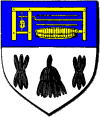 |
| Company of SILK-THROWERS. |
Argent, three bundles or hanks of silk in fesse sable; on a chief azure a silk-thrower's mill or--Company of SILK-THROWERS, London; incorporated 1630.Silkworm-fly: this occurs but in one coat of arms.
Per chevron argent and vert; in chief three silkworm-flies paleways en arriere in fesse; in base a mulberry branch; all counterchanged--BASSANO, Lichfield, co. Stafford.Silphium: this plant occurs but in one coat of arms, and that a singular one. The flower is similar to that of the chrysanthemum.
Vert, a chevron gules between two couplecloses erminois[sic] and three Turk's heads couped proper turbaned or; on a chief argent a silphium plant proper issuant from a mount vert inscribed with the letters KYPA gold--Admiral SMYTH.Silver. See Argent. The word is used to avoid repetition.
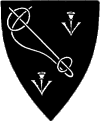 |
| CAWARDEN. |
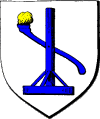 |
| MAGNALL. |
Sable, a staff-sling in bend between two pheons argent--CAWARDEN, or CARDEN, co. Cheshire and Hereford.Slip. See Tree.
Gules, a sling or hand-bow between two broad arrows argent--CAWARDEN, co. Stafford.
Argent, a sweep(or sling) azure charged with a stone or--MAGNALL.
Argent, on a mount vert a balista azure charged with a stone proper, a chief per fesse embattled or and gules--MAGNALL, Manchester and London; granted 1765.
 |
| Snail. |
Sable, a fesse between three house-snails argent--SHELLEY.Snake. See Serpent.
Gules, three snails argent in their shells or--BARTAN, Scotland.
Argent, a fesse vert between three house-snails azure--STUDMAN, Scotland.
Argent, a fesse vert between two snails in their shells in chief azure, and in base a thistle, leaved proper--STEDMAN.
Quarterly, first and fourth, per fesse or and gules a lion rampant counterchanged; second, or, a lion rampant with two heads azure; third, argent, a chevron gules between three snails sable--MASON, Yorkshire.
Gules, a snipe argent gorged with a crown or--SNITTERTON.Snout: of a mole, &c., when of a different tincture.
Azure, a fesse dancetty between three curlews or--SCOGAN.
Azure, the head of an avocetta proper--BINDER.
Sire Robert BORDET, [de azure a ij barres de or] en la sovereyne barre iij merelos de goules--Roll, temp. ED. II.
Monsire John FLEMINGE, barre d'argent et d'asur a trois oreillers de gules en la sovereign barre.--Ibid.
Monsire William CUSANCE, port d'argent a une bend engrele sable a une escalop en le sov'reign peice--Roll, temp. ED. III.
 |
| Spade. |
 |
| Half-spade. |
 |
| SWETTENHAM. |
Azure, two spades or--DAMPORT.
Azure, three spades argent within a bordure or--AYNESWORTH.
Azure, three spades argent, helved or--KNIPERSLEY.
Argent, on a bend vert three shovels bendwise in bend of the first--SWETTENHAM. [Various branches of the family vary the arms.]
Paly of six argent and gules, on a bend vert three half-spades of the first--SWETENHAM, Somerset.
Azure, three shovels argent--BEECHTON.
Azure, three irons or digging spades or--BECHETON.
Azure, three half-spades or, the side of each spade to the sinister--DAVERPORT.
Argent, a chevron between three half-spades[otherwise garden-spades] sable--STANDELFE.
 |
| Spade-iron. |
Azure, three spade-irons or, [otherwise blades of spades]--BECKTON.Spalding: a fish. See under Herring.
Argent, six sparrows, three, two and one sable; on a chief indented gules, two swords in saltire between as many wolf's heads erased or--SPAROW, London; granted 1516.Sparrow hawk. See Falcon.
... three sparrows ... --PHILLIP, Brignell, co. York.
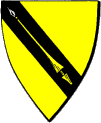 |
| SHAKSPERE. |
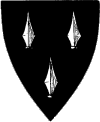 |
| PRYCE. |
Or, on a bend sable, a[tilting] spear of the field headed argent--SHAKSPERE, Warwick. [Granted by Dethick to the father of the dramatist, 1546.]For salmon-spear and eel-spear, see under Eel-spear.
Argent, five barrulets gules between three martlets in chief, and as many tilting spears paleways in base, azure--M'CALZIEN.
Azure, a battle-axe and tilting-spear in saltire argent headed or, in chief an arrow barways of the second headed and feathered of the third--GARBRAND.
Gules, a fesse ermine, over all two spears in saltire argent--CRAWFURD, Scotland.
Argent, seven half spears sable headed azure, three, one and three--DOCKER.
Sable, three spear-heads argent--PRYCE, Hunts.
Sable, a chevron between three leopard's heads or; on a chief as many spear-heads of the first embrued proper--PRICE, Marden, co. Hereford.
Or, on a bend azure a star between two crescents of the first, in chief a broken lance gules--SCOT, Whitislaid, Scotland.
Vert, a dart between two garbs or; on a chief azure a cherub's head proper between two estoiles argent--THACKERY.
Sable, a hand couped at the wrist grasping three darts, one in pale and two in saltire argent--LOWLE, Somerset.
Sable, a chevron between three darts, points upwards, shafts broken argent--AKENSIDE.
Sable, on a cross or between four unicorn's heads erased argent, armed, maned and tufted of the second, a cross engrailed gules charged with a javelin erect gold, headed as the third--WRIGHT, Manchester.
Sable, nine tilting-spears argent in parcels, three in each, viz. one in pale, two in saltire, wreath or--GARTEN, Sussex.
Azure, three fleurs-de-lis or, two and one; in chief spears issuing from the top of the field argent, each having a hook of the second, and beard on the dexter side--UNWYN, Horton, Yabington, co. Hants.
Argent, three pairs of spectacle vert, garnished or--Company of SPECTACLE MAKERS, London; Inc. 1629.Sperver. See Tent.
Gules, a chevron between three pairs of spectacles argent--STURMYN.
Argent, an oak-tree growing out of a mount in base vert; on one of the branches a pair of spectacles azure; on the top of the tree an eye proper--WAITE.
 |
| A terrestrial sphere. |
Azure, a sphere or--HARME, Surrey.
Azure, a pelican or, vulned proper, standing on a globe argent--John PIERSE, Bishop of Rochester, 1576; Salisbury, 1577; Archbishop of York, 1588-94.
Gules, three estoiles in chevron between as many lions rampant argent; [for augmentation] a chief or, thereon a portion of the terrestrial globe proper, the true meridian described thereon by a line passing from north to south sable, with the arctic circle azure; within which the place of the magnetic pole in latitude 70°5´17´´, and longitude 96°46´45´´west, designated by an inescutcheon gules, charged with a lion passant gardant of the first; the magnetic meridian shewn by line of the fourth passing through the inescutcheon with a correspondent circle, also gules, to denote more particularly the said place of the magnetic pole; the words following inscribed on the chief, viz., "Arctæos Numine Fines"--Sir John ROSS, C.B., Capt. R.N.
Azure, a globe, whereon are represented the Straits of Magellan and Cape Horn all proper; in the sinister chief point two herrings haurient in saltire argent crowned or; on a canton the united arms of Great Britain of the second--SOUTH SEA COMPANY, Established 1712.
Azure, a cross patty fitchy or; on a chief of the last three globes azure--ELDRED, Olavers, Stannaway, Essex.
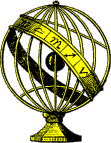 |
| Crest of the Company of CLOCKMAKERS. |
Gules, an armillary sphere or within an orle argent charged with eight mullets azure--CHAMBERLAIN, Baronetcy, 1828.A Hemisphere, or Demi-globe, occurs only as part of a crest.
Upon a helmet properly mantled gules, doubled argent, and wreath of three colours, a celestial sphere with a foot, or--Crest of the Company of CLOCKMAKERS.
On a wreath argent and gules, a cloud proper, thereon a celestial sphere azure, with the circles or; on the zodiac the signs Aries, Taurus, Gemini, and Cancer--The crest of BULL, Watchmaker to Queen Elizabeth.
Argent, on a fesse engrailed azure three mullets of the field, in chief a sphinx proper, all within a bordure engrailed gules--MOORE[as borne by Sir John Moore, K.B., the hero of Corunna].Harpy, (fr. harpie): an imaginary creature represented as a vulture with the head and breast of a woman.
Gules, three bars or, on a bend ermine a sphinx between two wreaths of laurel proper; on a chief embattled, a view of a fortified town with the word ACRE thereunder--CAMERON, co. Argyll.
Ermine, on a fesse engrailed azure three fleurs-de-lis or; in chief two branches of palm in saltire vert; in base a sphinx couchant proper--BERRY, Catton, Norfolk; extinct Baronetcy, created 1806.
Vert, a fesse engrailed argent surmounted of another gules between three harpies of the second crined or--MOODY, co. Wilts; Baronetcy, 1621.
Azure, a harpy displayed, crined, crowned and armed or--Given as the Insignia of NUREMBURG. [Guillim, ed. 1632, p. 263.]
De gueules, semé de fleurs-de-lis d'argent à une harpie de même--CALOIS DE MESVILLE.
 |
| Badge of RICHARD III. |
Or, three spiders azure--CHETTLE.Spike. See Nail.
 |
| Spire. |
... on a mount vert a castle with five spires argent--Town of QUEENBOROUGH, Kent.Spires of Grass, q.v.
Gules, three spires argent, on each a ball and cross or--DAKECOMBE, or DAKEHAM, Linc. and Salop. [Originally of Stepleton, Dorset.]
Sable, three spoons erect or--SPONELL.Spoonbill. See Heron.
 |
| Spur. |
Gules, a dexter hand holding a spear bendways between two spurs with leathers argent--GIB, Caribeer, Scotland.The term Spur-rowel is sometimes used in modern heraldry to signify a mullet, of six points, pierced. See old fr. rouwel, &c., under Rowel.
Argent, three palets gules; on a canton of the second a spur with the rowel downwards leathered or within a bordure engrailed sable--KNIGHT, Ruscombe, co. Berks.
Paly of six argent and azure; on a canton as the last a spur or--KNIGHT.
Gules, a spur-leather and buckle or; on a chief argent three cock's heads erased of the field, combed and wattled gold--COCKES, Somerset.
Argent, a chevron gules, between in chief two spurs, and in base a battle-axe azure, shaft or--CONNELL, Ireland.
Azure, two talbots in chief and a spur-rowel in base or--VIVIAN, France.
Vert, a horse argent caparisoned or; on a chief of the second three spur-rowels gules--STUDHOLME, co. Cumberland.
Argent, a bend engrailed between in chief two spur-rowels gules and in base a hunting-horn of the second garnished sable--GLASSFORD, Borrostounness, Scotland.
 |
| Square. |
 |
| SYDALL. |
Argent, a chevron between three carpenter's squares, points dexter sable--ATHOWE, or ATLOWE.The term square is found sometimes written for squire or Esquire, q.v., in the arms of MORTIMER, &c., and per square is found fancifully and improperly used for quarterly.
Argent, a chevron between three carpenter's squares, the angles in sinister chief, gules--Elias SYDALL, Bishop of St.David's, 1731; Gloucester, 1731-33.
Per pale argent and sable, a chevron between three mason's squares counterchanged--MASON.
Sable, a carpenter's square or--BEVILL.
Argent, on a chevron between three pairs of compasses extended sable, a joiner's square or, and a golden reel of line as the first--Company of CARPENTERS, London(Cotton MS. Tib. D. 10), [elsewhere, 'and a reel as the last,' stringed azure].
 |
| SAMWELL. |
Argent, two squirrels addorsed gules--SAMWELL.Two squirrels proper are the supporters of the arms of BOYD, Merton Hall, co. Wigton.
Argent, a chevron azure, between three squirrels sejant, cracking nuts sable--LOVELL, Norfolk.
Gules, a squirrel sejant cracking a nut or; on a chief of the last three fleurs-de-lis azure--STOKES.
Azure, a fesse between three squirrels argent cracking nuts or, within a bordure engrailed of the second--STOCKWOOD.
Ermine, on a chevron sable between three squirrels proper, with beads and chains of gold about their necks, three roses argent--Company of TAUYERS[or GREYTAWYERS, i.e. dressers of white leather], London; [Arms granted, 1531].
Sable, three pikestaves argent, two and one, on the top of each an annulet or--PIKE, Gottenburgh, Sweden; granted 1751.The staff raguly, or ragged-staff, occurs very frequently, and the term implies a branch of a tree, with the twigs lopped, and resembling a club. It is generally drawn couped, and then the term trunked is used; when throughout the better blazon would be a fesse or bend raguly. It will be observed that it is sometimes represented flammant, but perhaps in that case a fire-brand raguly would be the better blazon.
Argent, a chevron erminois between three flag-staves proper--HAWKE.
Azure, a chevron between three quarter-staffs argent--LONGSTAFF.
Gules, a griffin segreant or, holding a flag-staff bendy argent and sable, thereon a banner flowing to the dexter of the third, charged with an imperial eagle of the fourth--GABOTT, Acton-Burnell; also GARBETT. [Given by the Emperor Maximilian, Visit. London, 1568.]
Per chief indented azure and or; over all in bend a crosier, the staff gules, the crook of the first--Cistercian Abbey of BUCKLAND, co. Devon.
 |
| MERYCK. |
Azure, a fesse quarterly sable and argent between three ragged staves bendways or--WOODHOUSE, Calais.The shepherd's staff or crook is a long staff slightly curved at the top, or at least less so than the staff represented under crosier.
Argent, a ragged staff embowed to the sinister gules--ALTEN.
Argent, two ragged staves couped at the ends embowed one to the other sable--BOWSTOCK.
Argent, a lion rampant sable supporting a ragged staff azure--WILLISBY.
Sable, an eagle displayed argent, armed and standing upon a ragged staff fesswise or--BARLOW, co. Lancaster.
Sable, on a chevron argent between three staves raguly or, inflamed proper, a fleur-de-lys azure between two Cornish choughs--MERYCK, Bp. of Sodor and Man, 1575-99.
Argent, three staves raguly sable, flammant at the top proper--LAYLAND.
Vert, two shepherd's crooks in saltire or between three lambs passant, two and one argent--James SHEPHERD, New Green, Surrey.Some peculiar names occur, e.g. a Jacob's staff(possibly a shepherd's crook, but probably St.James' pilgrim's staff); the crutch staff, i.q. potent, and the Jedburgh staff. The Patriarchal staff is a staff surmounted by a double or Patriarchal cross, See Cross, §28.
Sable, two shepherd's crooks in saltire or between three garbs of the second--BENNETTE.
Azure, a Jacob's staff in pale between two estoiles or--John THURLOW, Burnham Overy, Norfolk; [granted 1664].The term staves is used in the sense of the handles of axes. See battle-axe, (hafted is a better term). Also of the rays of an escarboucle, q.v. Staved is also applied to branches; see under Tree.
Gules, on a horse salient argent furnished azure a chevalier armed at all points grasping in the right hand a kind of lance called the Jedburgh staff proper--Burgh of JEDBURGH, Scotland.
Argent, a savage gules, holding a club over the shoulder vert--GILHAM.Staff-tree: this shrub is the Celastrus of Linnæus, and its leaves are borne in one coat of arms.
Argent, three spiked club sable--BARSTON.
Argent, a chevron between three truncheons, each held in a sinister hand couped at the wrist or--STEVENSON.
Azure, three clubs[? icicles] in bend or--HARBOTTLE.
D'argent, a trois massues garnies de pointes de gueules rangées en fasce--BRUSSE, Pays Bas.
De gueules, à trois massues renversées d'argent--MACE, Normandie.
Azure, a chevron argent between three staff-tree leaves slipped or, as many bees volant proper--LEAF, Streatham, Surrey.Stafford's Knot. See Cords.
 |
| Staple. |
 |
| DUNSTAPLE PRIORY. |
Argent, on a pile sable, a staple affixed to the centre of the pile interlaced with a horseshoe or--DUNSTAPLE PRIORY, Beds.Star: for the conventional heraldic form of star see Estoile. In some late example of arms, however, the polar stars are represented. See also under Telescope and Neptune. A comet, q.v., is sometimes called a blazing star.
Argent, three staples sable--STAPLETON.
Argent, on a lion rampant sable a staple or on the shoulder--STAPLETON, co. Lancaster.
Argent, a chevron ermine between three staples sable--STAPLES.
Argent, a chevron between three door-staples gules--BRETON.
Argent, a saltire gules between four door-staples sable--STOCKTON.
Sable, a fesse wavy between the two polar-stars argent--Sir Francis DRAKE(the first English circumnavigator).Star-fish. See Mullet.
Azure, on a rock proper an eagle rising or, between in chief the arctic and in base antarctic polar stars; on a canton of the third a wreath of laurel vert fructed of the second--SOMERSET, London; granted 1771.
Azure, a mast of a vessel issuant from the base, thereon a sail hoisted and pendent flying proper between two estoiles in fesse or, representing the arctic and antarctic polar stars--ENDERBY, London; granted Aug. 12, 1778.
Azure, the sun and full moon in chief, and the seven stars in orbicular form(?) in base, all or--DE FONTIBUS, Bp. of Ely, 1220-25.
Sable, an escutcheon between starlings in orle argent--CALVERLEY.Statant, (fr. arrêté): a term signifying standing still with all the feet touching the ground, applied generally to animals, e.g. to a lion and wolf, q.v.; to some birds, e.g. a stork, q.v.; the heron being generally drawn so. Frequently it is applied to the griffin. To stags when in this position and gardant the term 'at gaze' is applied. The head of an animal statant may be gardant, but if so it should be mentioned.
Or, six starlings between three mullets sable, each charged with a bezant--PELTON.
Erminois, a fesse wavy azure between three starlings sable, beaked and lagged gules--GAMBIER, Baron Gambier.
Azure, a chevron between three sterns argent, beaked and legged gules--DUKE, co. Suffolk.
Argent, a griffin statant sable, armed azure--HALTON.Staved: applied to a branch. See under Tree.
Azure, a griffin statant or--GARDENER, London.
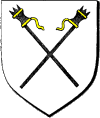 |
| NEWBY. |
Argent, two stilts in saltire sable, garnished or--NEWBY, Yorkshire.
 |
| Stirrup. |
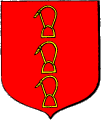 |
| DEVERELL. |
Gules, three stirrups with leathers in pale or--DEVERELL.Stock(1) of a Tree, q.v., (2) of an Anchor, q.v.
Azure, three stirrups with leathers or--GIFFORD, Staff.
Gules, three stirrups leathered and buckled or--SCUDAMORE, co. Hereford.
Azure, three stirrups or--PUREFOY, co. Leicester.
Azure, a stirrup between three mitres argent--Benedictine Abbey, EVESHAM, co. Worcester.
Vert, a chevron engrailed argent between in chief semy of torteaux two stags statant at gaze or, and in base a stirrup-leather gold--ROBINSON, co. Leicester.
Argent, three wall-stones[? bricks] in pale or--BRICKLEY.See also stone Billets; stone-bills under Wedge; and stone-fountains under Wells.
Or, a chevron quarterly azure and gules between three flint-stones of the last--STONE, co. Gloucester.
Vert, three flint-stones argent--FLINT.
 |
| DE EGLESCLIFF. |
 |
| GIBSON. |
 |
| STOREY. |
Or, a stork statant--John de EGLESCLIFF, Bp. of Connor, afterwards of Llandaff, 1323-47.Straps: these only incidentally occur in connection with armour, collars, stirrups, &c. In one case they are distinctly mentioned, namely, as wrist straps, and in another case they are named as part of a badge of office.
Argent, on a chevron between three storks, as many swans proper--POULTERERS' Company, [Inc. 1504].
Or, a stork proper--SERJEANTS' INN, Chancery Lane.
Argent, a stork sable, beaked and membered gules--STARKEY, co. Derby.
Azure, three storks, wings expanded argent--GIBSON, Swindon, co. Wilts.
Azure, three storks rising argent--GIBSON, Bp. of Lincoln, 1716, and of London, 1723-48.
Party per fesse argent and sable, a pale counterchanged, three storks close of the second--Edward STOREY, Bp. of Carlisle, 1468, and of Chichester, 1478-1502.
Azure, three clubs argent, with wrist straps gules--MAZZINGHI, London.Straps. See examples introduced under Staff(club), and under Tree.
Azure, on oak-tree growing out of a mount in base or, and on one of the branches two keys of the first fastened by straps gules[for the office of Thane of Fettercairn]--WOOD, Balbegno, Scotland.
Sable, on a bend between in chief a greyhound courant bendwise and in base a dolphin haurient argent, three torteaux; a chief of the second charged with three sprigs of strawberry fructed proper--HOLLIST, Midhurst, Sussex.Streamer: a long narrow flag.
Azure, three garbs or with a strawberry leaf in the centre--CUMING, Moray, temp. James V.
Azure, three frasiers argent--FRASER, Pitcallain.
Azure, a lion rampant argent crowned with an antique crown or armed and langued gules within a bordure of the second charged with six frasiers of the first--MAC DOUGALL, Mackerston, co. Roxburgh.
Azure, three sturgeons argent fretty gules--STURGNEY.Subinscribed: i.e. with Letters, or a name written beneath the charge; found only in very modern arms.
Azure, three sturgeons naiant in pale or, over all a fret gules--STURGEON, Whipsted, Suffolk.
 |
| Sugar-cane. |
Argent, two sugar-canes in saltire proper surmounted by a fleur-de-lis gules; on a chief azure three plates, each charged with a mullet sable--FOULKS.Sugar-loaves were borne by one family in Somerset, and Dr.Sugar added a Doctor's Cap in chief.
Argent, on a fesse wavy azure, between in chief two bucks trippant and in base two sugar-canes in saltire, surmounted by a bill in pale all proper, three estoiles or--TIMPORIN, co. Hertford.
Or, on a chevron gules, between three martletts sable, two sugar-canes of the first--FENWICK.
Sable, three sugar-loaves argent, in chief a Doctor's cap--Dr.SUGAR, New College, Oxford.Sun, (fr. soleil): this luminary is usually borne in his glory, or splendour, that is to say, with a human countenance(fr. figuré), and rays(sixteen or more), alternately straight and waves. When depicted without a face, the French blazon it ombre de soleil.
 |
| RICHMOND. |
Gules, the sun in his glory argent--RICHMOND.Sun Eclipsed: the sun or moon when borne eclipsed is drawn exactly as when in his glory, or her complement, but sable.
Argent, the sun in splendour or--DELAHAY.
Or, on a pile azure, between two lions rampant combatant in base gules, the sun in splendour proper--PEARSON, co. Lincoln.
Azure, a sun in splendour or--Town of BANBURY.
Gules, two bars ermine in chief three suns in glory or--NICHOLSON, co. Down.
Azure, the sun rising from behind a hill or--HILL, Edinburgh.
Gules, an eagle displayed or looking against the sun in its splendour placed toward the dexter chief--The feudal coat of the lordship of CARDROSS.
Or, a sun gules[otherwise radiated gules]--HAYS, co. Dorset.
Per pale or and azure, a sun counterchanged--ST.CLERE, Tidwell, co. Devon.
Azure, seven suns or, three, three and one--ELHAM.
Azure, on a fesse, between three goat's heads couped argent collared gules, the sun radiated or between two mascles sable--GASON, Kent[temp. Hen. VIII.].
D'or, à l'ombre de soleil d'azur--DUPONT, Languedoc.
Argent, a sun eclipsed issuing out of the dexter chief, the beams or--WELDAY, Wheelhurst.See also the curious example in the insignia of the DISTILLERS' COMPANY under Distillatory.
Azure, the sun half-eclipsed[i.e. per pale, sable and or]--DYSON, co. Worcester.
Azure, a heliotrope(or sunflower) or issuing from the stalk sprouting out of two leaves vert; in chief the sun in splendour proper--FLORIO[originally of Spain; granted 1614].Super charge: a charge surmounting another is by some writers referred to by this term.
D'argent, au tournesol d'or tigé feuillé et terrassé de sinople--GUILLOIS, Ile de France.
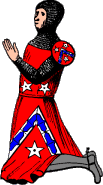 |
| Sir Richard(?) TURVILLE. |
Gules, a chevron vair, between three mullets pierced argent--TURVILLE.
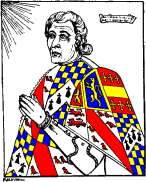 |
| Sir John TALBOT. |
The quarters seen upon the body of the surcoat are, Argent, a bend between six martlets--FURNIVALL: and checquy or and azure, a chevron ermine-arms of the ancient Earls of WARWICK. On the sleeve, Gules, a lion rampant with a bordure engrailed or--TALBOT: Azure, a lion rampant with a bordure or--DE BELESME: Gules, a fesse between six cross-crosslets or--BEAUCHAMP: Argent, two lions passant gules--STRANGE of Blackmere: together with FURNIVALL, and WARWICK as before.Ladies formerly wore the arms of their husbands upon their mantles, and their own upon their close-fitting vests. Eleanor, Countess of Arundel, who died 1372, is thus depicted in the east window of Arundel church, Sussex. At a later period the arms were borne impaled on the outer garment; e.g. Elizabeth, wife of John SHELLEY, Esq., on a brass at Clapham, Sussex, 1513.
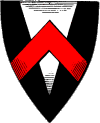 |
| DYXTON. |
 |
| LATIMER. |
Sable, a pile argent, surmounted by a chevron gules--DYXTON.The above being the correct signification of the term it must not be overlooked that it is sometimes used irregularly for describing one charge above, i.e. in chief of, another, and this is especially the case in modern French heraldry, when surmonté or sommé de is very frequently, if not always, used with this signification. The terms brochant(or bronchant) sur le tour are more usually employed by French heralds for the true signification of surmounted by. (See Over all.)
Gules, a cross patonce or, surmounted of a bend azure semy of fleurs-de-lys of the second--HUGH LATIMER, Bp. of Worcester, 1535-39.
Gules, a chevron chequy or and azure surmounted by a bend ermine--HANSTED.
Argent, a fir-tree growing out of a mount vert in base, surmounted by a sword in bend proper; on a dexter canton azure a royal crown proper--GREG, co. Chester.
Gules, a fesse argent surmounted by a chevron azure[From Burke's Armory]. Gules, a fesse argent, over all a chevron azure[From Papworth's Ordinary]--BROADHURST.
Argent, a heart gules, surmounted by[should be ensigned with] a regal crown, on a chief azure three mullets argent--DOUGLAS. [From Burke's Illustrations.]Surtout, also sur le tout(fr.): the English 'over all' is more usually substituted; while the French used the term brochant sur le tout; it is especially applied to an escutcheon of pretence.
Per chevron argent and gules three skenes surmounted with as many wolf's heads[better, 'on the point of each a wolf's head'] counterchanged--SKENE, Newtile, Scotland. [From Burke's Armory.]
Gules, a castle surmounted with a tower argent; in base a lion passant gardant or--City of NORWICH. [From Papworth's Ordinary.]
De gueules, au chêne d'argent surmonté d'une fleur-de-lis d'or[i.e. with the fleur-de-lis in chief]--DE REALS, Languedoc.
De gueules, à une forteresse d'or a trois tours du même, celle du milieu sommée d'une grue, tenant sa vigilance du même[i.e. the crane stands on the top of the central turret]--DE BOILEAU DE CASTELNAU, Languedoc.
Sable, six swallows 3, 2, 1, argent--Family of ARUNDEL of Wardour.Swan, (lat. cygnus, fr. cygne): this graceful bird has for various reasons been a favourite charge in armorial bearings. Swans are generally blazoned as proper, i.e. white, else they are described as argent, but they are frequently beaked and legged of other tinctures. The bird is generally borne with expanded wings, and it seems desirable that the position should be noticed, though as a fact it is only seldom so. Sometimes they are drawn swimming towards each other, and for this the word 'respectant' or 'incontrant' seems to have been used by some heraldic writers.
Argent, a swallow volant in bend sinister sable--Town of ARUNDEL, Sussex.
Or, a fesse azure between four barrulets wavy of the last: on a canton of the second two barrulets argent, charged with three swallows volant sable, viz. on the first two, second one--ALLOTT, co. York; granted 1729.
Argent, a fesse between three swallows volant sable--SWALLOW.
Argent, a cross raguly gules between four swallows[otherwise 'birds'] azure legged of the second--ANSTIS, Cornwall.
Argent, a chevron between three martins sable--MARTINSON, Newcastle-on-Tyne.
 |
| MELLISH. |
Azure, two swans close in pale argent between as many flaunches ermine--MELLISH.The head and neck of a swan are blazoned a swan's neck; the wings are also met with.
Azure, a swan proper--SWAN, Kent.
Azure, a fesse between three swans argent--SWAN, ob. 1487.
Gules, three swans argent--SWANLAND, Lord Mayor of London, 1329.
Sable, a swan its wings expanded argent, within a bordure engrailed or--MOORE, Hants.
Azure, a fesse or, between three swans argent beaked and legged gules--GISLINGHAM, Suffolk.
Gules, a bend sable between two cotises or, and as many mullets and as many swans argent--RUSSELL.
Per saltire; in chief argent, a cross gules; in the dexter flank gules, a lion passant gardant or; in the sinister flank or, a red rose; in base azure, a swan eating an eel proper--Town of GOREY, Ireland; granted 1623.
Sable, two swans in pale, wings addorsed argent, between as many flaunches or, on a chief gules a garb between two fleurs-de-lis of the third--FITLER.
Per pale sable and gules, a swan, wings expanded argent, ducally gorged and[sometimes] chained or--Town of BUCKINGHAM.
Azure, a fesse engrailed or, surmounted of another gules charged with three roses argent, all between as many swans sans legs proper--RIVERS, Kent; Lord Mayor of London, 1573.
Sable, two swans[rather geese] incontrant[otherwise in fesse incontrant regardant] argent--TREGOSSE.
Swans are borne by the following families amongst others:--
ATWATER, Kent.--BADBY, Suffolk.--BALDEN, Norfolk.--BOLDEN, Lancaster,--BRACY.--BRODERIP.--BRYSE.--CAZIER, London.--CHARLTON, London.--CLARKE(see under Pellet).--COBB(see under Herring).--COBLEY.--COPPARD, Sussex.--CRESSINGHAM.--DALE, York and Northumberland.--DAWES, Norfolk.--DELANEY.--ELKINGTON.--FATTOR, Norfolk.--FOLNARBY.--HOBBES, Wilts.--JENYSONN, Norfolk.--LANNOY, Hammersmith.--LEIGHAM.--LIGHT, Oxfordshire.--LOVENHAM.--LYTE, Somerset.--MICHELL, Somerset.--MOLSFORD, Devon.--MORE, Devon.--PELFYN.--PHILLPOT, Hereford.--PICKERELL, London.--REDDIE.--SCOTER.--SHELDON.--STORMER.--SUTER.--SYNNOT, Wexford.--SWABEY, Bucks.--VAUGHAN.--WALTON, Lancashire.--WATERS[York Herald, temp. Ric. II.].--WOLRICH, Salop.--WYBERNE, Kent.--YEO, Devon.
 |
| LACY. |
Azure, five swan's necks erased argent--LACY, alias HEDGES, London; also co. Oxford.The Cygnet sometimes occurs; and a cygnet royal implies a swan gorged with a ducal coronet, having a chain affixed thereunto and reflexed over its back. It should rather be blazoned a swan proper, ducally gorged and chained or, a cygnet being properly a young swan. It was one of the badges of Henry V. The term, however, may properly be used when there are two or more swans in one coat, like lioncel.
Sable, three swan's heads couped at the neck argent--Samuel SQUIRE, Bp. of S.David's, 1761-66.
Argent, a martlet sable; on a chief azure three swan's wings endorsed of the first--SWANSTON, Scotland.
 |
| Badge of HENRY V. |
Azure, a bend engrailed between two cygnets argent gorged with ducal crowns, with strings reflexed over their backs or--PITFIELD, Dorset.Sweep. See Sling.
Gules, a cygnet argent--Thomas ASDALE.
A beacon or, inflamed proper.--An antelope gorged with a crown and chained.--A swan adorned in a like manner. Three badges of HENRY V., from cornice of his chantry, Westminster Abbey.
 |
| Swivel. |
Argent, on a chevron gules between three steel gads azure as many swivels, the middle one palewise, the other two in the line of the chevron or--Company of IRONMONGERS; arms granted, 1455: confirmed, 1530.Sword, (fr. epée), or arming sword: the usual form is a long straight blade, with a cross handle, and it is borne in a variety of ways, so that its position should be distinctly stated. The sword in the insignia of the city of London is sometimes called the sword of S.Paul, that apostle being patron of the city. The blade may be waved, embrued, &c. A sword is often represented piercing an animal or a human heart.
 |
| NORTON. |
Or, a sword in bend sable--SMALLBROOK, co. Worcester.There are different kinds of swords mentioned in blazon, e.g. the arming sword, the sword of state, the Irish sword, the Highlander's Claymore, &c.
Sable, a sword erect in pale argent, hilt and pomel or--DYMOCK.
Azure, three swords, one in pale, point uppermost, surmounted by the other two in saltire, points downward, argent--NORTON.
Gules, a man's head couped at the shoulders between three swords proper headed or--SWORD.
Gules, a lion rampant argent between two swords, pomels downwards, points to the dexter and sinister chief proper--DEMSEY.
Gules, three pairs of swords in saltire argent, hilts and pomels or, viz. two pairs in chief and one pair in base--CUTLERS' COMPANY, [Incorporated 1417; arms granted 1476].
Argent, a sword in pale azure, hilted or; a chief gules--MENZIES, Culdairs.
Gules, on a chief argent two swords in saltire azure--BRADDYLL.
Argent, a two-handed sword in pale azure--SPALDING, Scotland.
Gules, a two-handed sword bendwise between two mullets or--SYMONSTON, Symonston.
Azure, a waved sword erect in pale proper, hilt and pomel or, between two mullets in fesse pierced argent--DICK.
Argent, a sword erect, point upwards; from the blade issuing drops of blood--O'DAVOREN, Ireland.
Gules, a fesse between three pheons argent on a canton or, a dexter gauntlet sable holding a broken sword erect of the second embrued in blood--EGERTON, Dublin.
Azure, two swords in saltire, blades argent, hilts and pomels or, pierced through a human heart proper; in chief a cinquefoil azure--PARSONS.
Or, three sword points proper, two and one--PROCTOR.
"The Highlander, whose red claymore
The battle turned on Maiden's shore."
Scott's Marmion, Introd. to Canto VI.
Sable, an arming sword, the point in chief argent--MARMION.The sword may be sheathed, i.e. in its scabbard, the termination of which is called the crampet, chape, or boteroll, (fr. bouterol); and this termination is sometimes found as a separate charge. [The habick of the CLOTH-WORKERS' Company is found wrongly blazoned as a crampet.]
A sword of state palewise, point downwards, surmounted of two lions passant; impaling quarterly, first and fourth chequy argent and sable, second and third gules, two barrows[sic but Qy.] or--Seal and Arms of the Corporation of DROITWICH, co. Worcester.
Argent, issuing from the sinister side of the shield a cubit dexter arm vested gules, cuffed azure, the hand proper grasping an old Irish sword, the blade entwined with a serpent proper--O'DONOVAN, Ireland.
Azure, a cat rampant argent, on a chief the standard of St.Andrew and a claymore, point downwards, in saltire proper--SMITH, London.
 |
| Badge of DE LA WARR. |
Argent, two swords in their scabbards in saltire sable, hilts and chapes or--GELLIBRAND, co. Kent, temp. HEN. VIII. [N.B. Brand is a word for sword.]Sword-fish: this fish has been observed named but in one of arms.
Sable, a sword in pale, point downwards, scabbard and belt argent, on the sinister side a Katherine wheel argent--GARAT GROCH.
A crampet or, the inside per pale azure and gules, charged with the letter r of the first--Badge of Earl DE LA WARR.
Azure, three bouterolls or--BECHETON[or Becketon].
Sable, three sword chapes or--ADDERTON, co. York.
Gules, a blade of a sword-fish argent crowned or--LESSIEURE, Middlesex.Sykes. See Fountain.